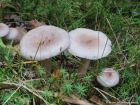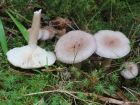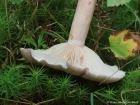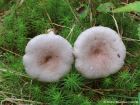Cap thin-fleshed, at first convex with an often small central bump, later flattening and finally becoming shallowly funnel-shaped. The surface is smooth, moist to sticky when wet, grey to purplish-grey or brownish-grey, sometimes with violet or flesh tones, and it pales with age. The margin is often faintly whitish and sometimes faintly zoned. The flesh is whitish to pale buff, fragile and brittle. Gills crowded, adnate to shortly decurrent, whitish to pale yellowish, and bruising brownish. They exude white milk that slowly turns grey. Stem cylindrical or narrowing slightly towards the base, smooth and brittle, pale greyish to buff with a hint of the cap colour, usually paler at the top, and often becoming hollow with age. It has no ring. Spore print pale cream to yellowish, sometimes with a slight salmon tinge.
Microscopic Features: The spores are subspherical to broadly ellipsoidal, measuring 7–9.5 × 5.5–7.5 µm. They are ornamented with warts and ridges up to 0.8 µm high, forming a partial and often well-developed closed mesh or reticulum.
Lactarius vietus on the First Nature website.
Many mushrooms are poisonous, and some can be lethally toxic. Distinguishing between edible and poisonous mushrooms can be very challenging. Therefore, we strongly advise against consuming wild mushrooms. This website does not contain any information about the edibility or toxicity of mushrooms.
Although efforts have been made to ensure accuracy on this website, the information may contain errors and omissions. Therefore, all content provided is for educational and informational purposes only and should not be relied upon or used as a basis for consuming any plants or mushrooms.
External links are provided for reference only. We do not endorse or take responsibility for the content, advice, or products found on these sites or in any advertisements shown on this website.



